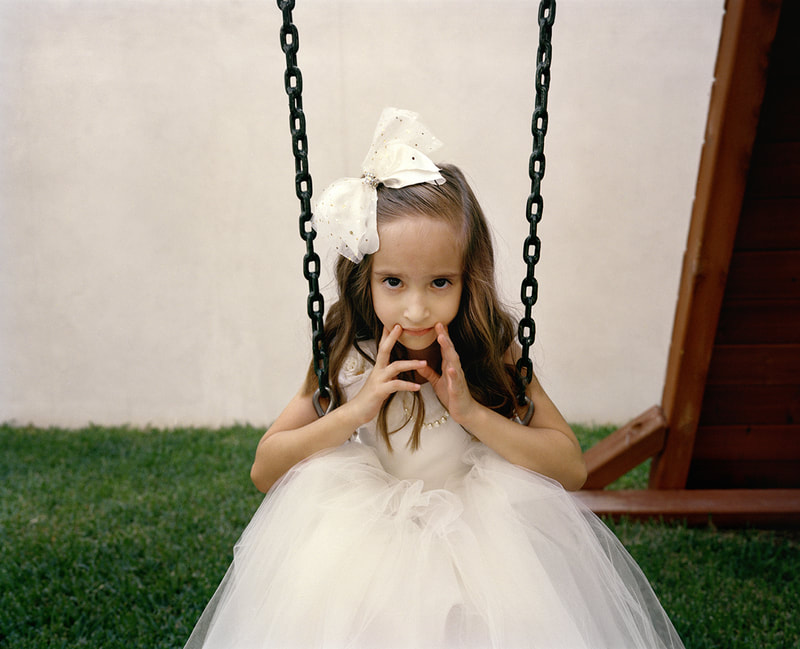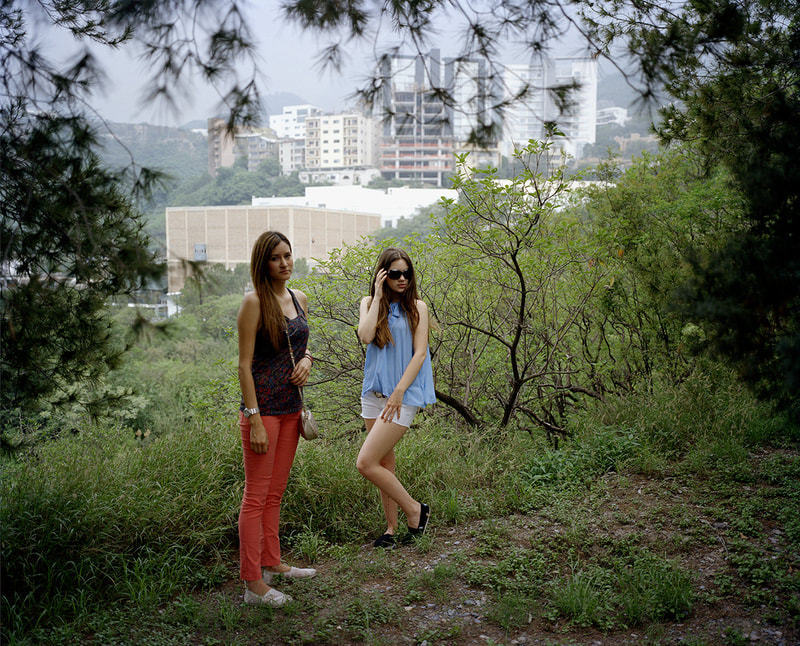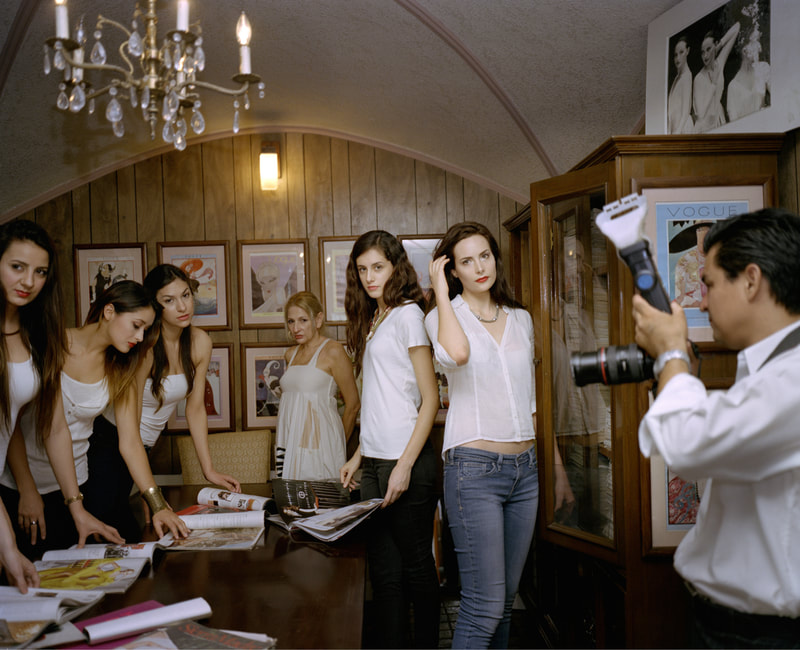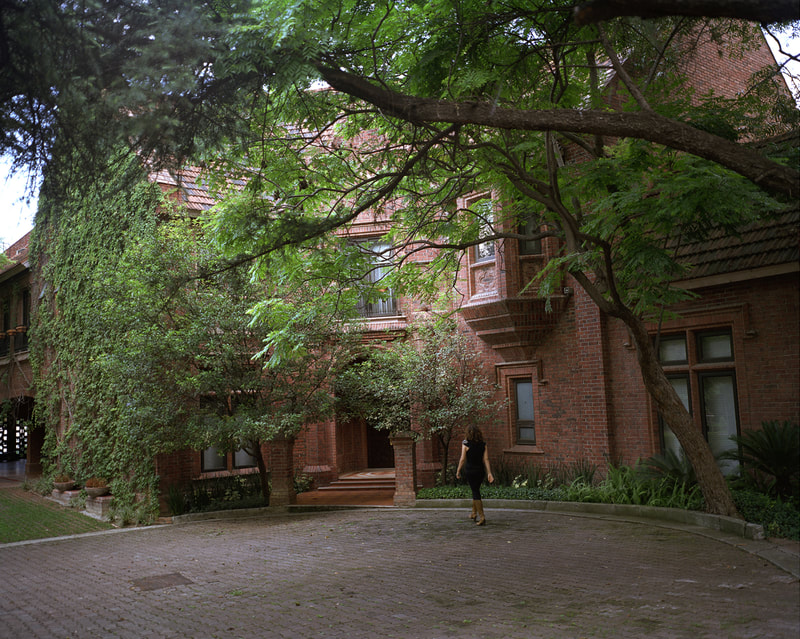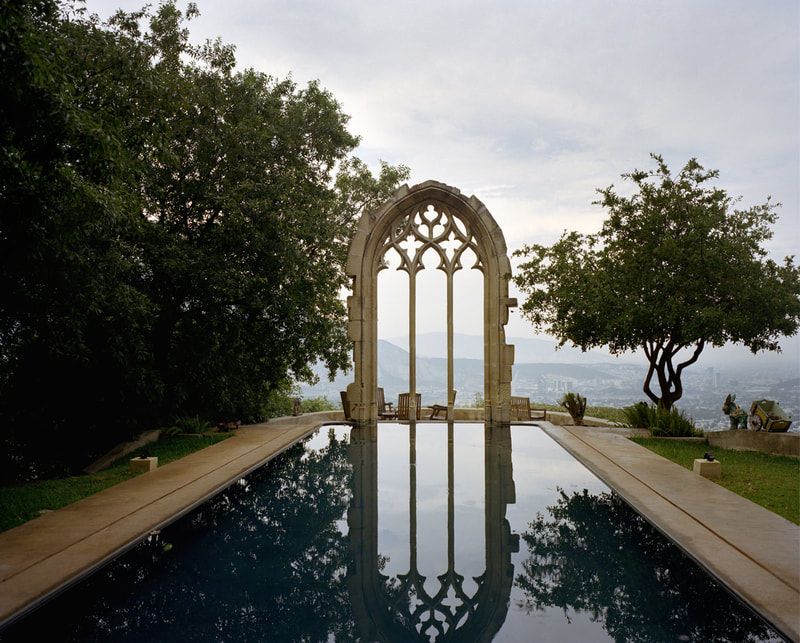This text is included in the book San Pedro Garza Garcia, and was written by Yvonne Venegas to accompany the images.
I dreamt that on a visit to San Pedro Garza García1 I met the French sociologist and philosopher Pierre Bourdieu.2 Sharing a fascination with people, we observed together the town’s social life which, like a theater play being performed in a space delimited by the gazes of the spectators, was unfolding in a place where the mountains played the role of protectors of its purity. The women, on the other hand, allowed us access. They surrendered their own images, fulfilling their desire to be seen by others, in addition to those inhabiting the space. It seemed they knew something about beauty, about its power to communicate.
San Pedro Garza García was founded in 1882, though it was only in the middle of the last century that it began to turn into one more urban district of the metropolitan zone of Monterrey. It has a population of approximately 150,000 and occupies one of the highest ranks in terms of wealth and human development in all of Latin America.3 All this led me to focus on the character of its society, which from the beginning looked beyond the harshness of the scorching climate and the horizon outlined by the Sierra Madre Oriental4 to create its own possibilities.
Following the Mexican Revolution, Monterrey, which is not far from Texas, worked hard to become one of the most important industrial cities in the country, always finding ways to exploit its proximity to the US border. By 1978 its economic clout was such that Mexican president José López Portillo asked the city’s business community to assume dollar debt in order to aid the Mexican economy. Today the fortunes of families in San Pedro Garza García can be measured in the billions of dollars.
Between 2013 and 2017 I visited San Pedro often to take photos, without really knowing what I was looking for. Family get-togethers, weddings, barbecues, art openings, beauty parlors, houses, landscapes; portraits of people I was acquainted with through my contacts, one after another, without posing many questions. What interested me was being there, portraying and getting to know the people, blindly looking for something which, with the help of images, I began to understand in part, but which still holds a mystery for me, as if the inhabitants of the place were maintaining a unanimous silence to protect it.
In 1975 the newspaper El Norte, one of Mexico’s most important dailies, launched a society pages supplement called Sierra Madre, devoted exclusively to the residents of the municipality of San Pedro Garza García. It invited people to inform the newspaper by telephone of any social event or other activity that might be of interest. The supplement started out as six pages inside the newspaper and by 2016 had become an independent magazine of 220 pages, distributed free, in which advertisements occupied as much space as the articles.
The success of the magazine was resounding. According to sociologist María Elizondo Tijerina,5 the format connected with the way people related to one another, with how they understood their own image and undertook to transmit over time their ideas of celebrity, self-promotion, and status. It took me some time to understand that not everyone thinks the same thing about magazines of this kind. Some people are not in agreement with this way of classifying society, whereas others, eager to appear in the magazine, continue inviting it into their homes when something special takes place there. And they even, on occasion, wanted me to portray them.
One of my first guides introduced me to San Pedro through a pile of society mags, Sierra Madre among them, with the simple explanation that there I would find the people who were important to my project. The magazines, full of faces with practiced smiles gazing at the camera, seem to promise an unattainable happiness. There were also, albeit more rarely, people whose fleeting expressions hinted at a gesture of dissent, faces resigned to participating in something that seemed inevitable to them.
With the help of several women friends, my first steps in Garza society were fluid and easy: I was looking for certain people and they wanted to be photographed. As docile subjects, they posed and attentively followed my instructions. I could take as many photos as I liked, with no questions asked, no signatures, no promises. I felt there was a real opportunity there: that feeling in the air of San Pedro that everything seems to open up for you as long as you show you are working. A few people ―though we never talked about it― thought that appearing in my book might even give them a certain status.
After taking many photos of those who wanted to be photographed, my next steps into other social brackets were slower, as the people I met became more careful about their images. In the highest echelons, the work of Daniela Rossell6 had left its mark, and there was a distrust of contemporary art as a latent threat to the self-image they had created. We are all aware of the social tensions due to class differences experienced every day in Mexico, which is why there is also a fear of criticism. I shall be forever grateful to those who did allow me to photograph them, for I know they have shared with me an invaluable treasure: their image.
A friend once said to me: “Pierre in San Pedro, so many Peters.” Inspired by Bourdieu’s work on the reproduction of social hierarchies, I looked for a way to represent in this book all the social scales I had become familiar with, which I felt ―though I am by no means an expert on the subject― were more varied and complex than anywhere else in Mexico. What I have managed to do is to translate what I saw: that social bubble which is able to surround itself with beauty, which lives with its own culture and ideology in the midst of a developing country. And yet, although the signs of external life are muted, its translucent walls still reveal the existence of those of us who are outside.
1 The municipality was originally called Garza García, but the inhabitants had the name of San Pedro (St. Peter) added to it, and now the original name is all but forgotten.
2 The French thinker Pierre Bourdieu (1930-2002) was one of the most important sociologists of the twentieth century. His work centered on the sociology of culture, education, the media, and lifestyle. His books Distinction (1979) and Photography: A Middle-Brow Art (1965) have been important references during the execution of this project.
3 Instituto Nacional de Estadística y Geografía (INEGI), 2009.
4 The Sierra Madre Oriental is a mountain range extending for approximately 1,350 kilometers across the Mexican states of Nuevo León, Tamaulipas, Coahuila, San Luis Potosí, Hidalgo, Puebla, Tlaxcala, and Veracruz.
5 María de los Ángeles Elizondo Tijerina, “Una aplicación de la ‘Teoría de la Clase Ociosa’ en el suplemento social Sierra Madre,” master’s thesis in social science for the Universidad Autónoma de Nuevo León (May 2013).
6 Daniela Rossell (b. 1973), a Mexican artist who in 2002 published a book of photographs entitled Ricas y Famosas (Rich and Famous), which presents a satirical portrayal of Mexican women of the upper class. The publication raised hackles on all sides, with criticisms also finally leveled at the women who appeared in it. Thirty percent of the photographs were taken in San Pedro Garza García. See Daniela Rossell, Ricas y Famosas (Madrid: Turner/Hatje Cantz, 2002).
I dreamt that on a visit to San Pedro Garza García1 I met the French sociologist and philosopher Pierre Bourdieu.2 Sharing a fascination with people, we observed together the town’s social life which, like a theater play being performed in a space delimited by the gazes of the spectators, was unfolding in a place where the mountains played the role of protectors of its purity. The women, on the other hand, allowed us access. They surrendered their own images, fulfilling their desire to be seen by others, in addition to those inhabiting the space. It seemed they knew something about beauty, about its power to communicate.
San Pedro Garza García was founded in 1882, though it was only in the middle of the last century that it began to turn into one more urban district of the metropolitan zone of Monterrey. It has a population of approximately 150,000 and occupies one of the highest ranks in terms of wealth and human development in all of Latin America.3 All this led me to focus on the character of its society, which from the beginning looked beyond the harshness of the scorching climate and the horizon outlined by the Sierra Madre Oriental4 to create its own possibilities.
Following the Mexican Revolution, Monterrey, which is not far from Texas, worked hard to become one of the most important industrial cities in the country, always finding ways to exploit its proximity to the US border. By 1978 its economic clout was such that Mexican president José López Portillo asked the city’s business community to assume dollar debt in order to aid the Mexican economy. Today the fortunes of families in San Pedro Garza García can be measured in the billions of dollars.
Between 2013 and 2017 I visited San Pedro often to take photos, without really knowing what I was looking for. Family get-togethers, weddings, barbecues, art openings, beauty parlors, houses, landscapes; portraits of people I was acquainted with through my contacts, one after another, without posing many questions. What interested me was being there, portraying and getting to know the people, blindly looking for something which, with the help of images, I began to understand in part, but which still holds a mystery for me, as if the inhabitants of the place were maintaining a unanimous silence to protect it.
In 1975 the newspaper El Norte, one of Mexico’s most important dailies, launched a society pages supplement called Sierra Madre, devoted exclusively to the residents of the municipality of San Pedro Garza García. It invited people to inform the newspaper by telephone of any social event or other activity that might be of interest. The supplement started out as six pages inside the newspaper and by 2016 had become an independent magazine of 220 pages, distributed free, in which advertisements occupied as much space as the articles.
The success of the magazine was resounding. According to sociologist María Elizondo Tijerina,5 the format connected with the way people related to one another, with how they understood their own image and undertook to transmit over time their ideas of celebrity, self-promotion, and status. It took me some time to understand that not everyone thinks the same thing about magazines of this kind. Some people are not in agreement with this way of classifying society, whereas others, eager to appear in the magazine, continue inviting it into their homes when something special takes place there. And they even, on occasion, wanted me to portray them.
One of my first guides introduced me to San Pedro through a pile of society mags, Sierra Madre among them, with the simple explanation that there I would find the people who were important to my project. The magazines, full of faces with practiced smiles gazing at the camera, seem to promise an unattainable happiness. There were also, albeit more rarely, people whose fleeting expressions hinted at a gesture of dissent, faces resigned to participating in something that seemed inevitable to them.
With the help of several women friends, my first steps in Garza society were fluid and easy: I was looking for certain people and they wanted to be photographed. As docile subjects, they posed and attentively followed my instructions. I could take as many photos as I liked, with no questions asked, no signatures, no promises. I felt there was a real opportunity there: that feeling in the air of San Pedro that everything seems to open up for you as long as you show you are working. A few people ―though we never talked about it― thought that appearing in my book might even give them a certain status.
After taking many photos of those who wanted to be photographed, my next steps into other social brackets were slower, as the people I met became more careful about their images. In the highest echelons, the work of Daniela Rossell6 had left its mark, and there was a distrust of contemporary art as a latent threat to the self-image they had created. We are all aware of the social tensions due to class differences experienced every day in Mexico, which is why there is also a fear of criticism. I shall be forever grateful to those who did allow me to photograph them, for I know they have shared with me an invaluable treasure: their image.
A friend once said to me: “Pierre in San Pedro, so many Peters.” Inspired by Bourdieu’s work on the reproduction of social hierarchies, I looked for a way to represent in this book all the social scales I had become familiar with, which I felt ―though I am by no means an expert on the subject― were more varied and complex than anywhere else in Mexico. What I have managed to do is to translate what I saw: that social bubble which is able to surround itself with beauty, which lives with its own culture and ideology in the midst of a developing country. And yet, although the signs of external life are muted, its translucent walls still reveal the existence of those of us who are outside.
1 The municipality was originally called Garza García, but the inhabitants had the name of San Pedro (St. Peter) added to it, and now the original name is all but forgotten.
2 The French thinker Pierre Bourdieu (1930-2002) was one of the most important sociologists of the twentieth century. His work centered on the sociology of culture, education, the media, and lifestyle. His books Distinction (1979) and Photography: A Middle-Brow Art (1965) have been important references during the execution of this project.
3 Instituto Nacional de Estadística y Geografía (INEGI), 2009.
4 The Sierra Madre Oriental is a mountain range extending for approximately 1,350 kilometers across the Mexican states of Nuevo León, Tamaulipas, Coahuila, San Luis Potosí, Hidalgo, Puebla, Tlaxcala, and Veracruz.
5 María de los Ángeles Elizondo Tijerina, “Una aplicación de la ‘Teoría de la Clase Ociosa’ en el suplemento social Sierra Madre,” master’s thesis in social science for the Universidad Autónoma de Nuevo León (May 2013).
6 Daniela Rossell (b. 1973), a Mexican artist who in 2002 published a book of photographs entitled Ricas y Famosas (Rich and Famous), which presents a satirical portrayal of Mexican women of the upper class. The publication raised hackles on all sides, with criticisms also finally leveled at the women who appeared in it. Thirty percent of the photographs were taken in San Pedro Garza García. See Daniela Rossell, Ricas y Famosas (Madrid: Turner/Hatje Cantz, 2002).

